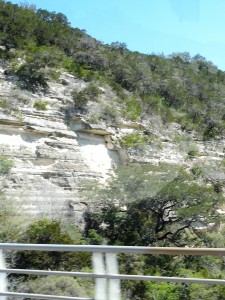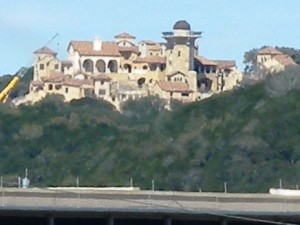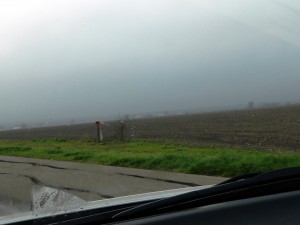» posted on Sunday, March 4th, 2012 by Linda Lou Burton
The Balcones
 Linda Burton posting from Austin, Texas – Some say it’s where the south ends. On the east side of town is the rich black bottomland that once sustained the cotton economy of the old south; it’s an agricultural haven to this day. But in Austin, that farmland literally runs into a wall. That’s where it meets a bulwark of cracked and weathered rock, the beginning of the Texas Hill Country I’d heard about but couldn’t visualize before today. Now it’s clear to see; we’re west of town, parked at an overlook for a glimpse eastward towards the city; tall buildings rise high in the distance. The hills are sparse with vegetation, yet plentiful in high-end houses, perched and angled for the ultimate view. What once was considered “unproductive” from an agricultural standpoint is the high-dollar ticket for Texas real estate now. The demarcation line, that “wall,” is the Balcones Escarpment.
Linda Burton posting from Austin, Texas – Some say it’s where the south ends. On the east side of town is the rich black bottomland that once sustained the cotton economy of the old south; it’s an agricultural haven to this day. But in Austin, that farmland literally runs into a wall. That’s where it meets a bulwark of cracked and weathered rock, the beginning of the Texas Hill Country I’d heard about but couldn’t visualize before today. Now it’s clear to see; we’re west of town, parked at an overlook for a glimpse eastward towards the city; tall buildings rise high in the distance. The hills are sparse with vegetation, yet plentiful in high-end houses, perched and angled for the ultimate view. What once was considered “unproductive” from an agricultural standpoint is the high-dollar ticket for Texas real estate now. The demarcation line, that “wall,” is the Balcones Escarpment.
 The Balcones Escarpment, which forms the eastern boundary of the Texas Hill Country and the western boundary of the Texas Coastal Plain, consists of cliffs and cliff-like structures. It is geology’s most fateful mark upon the surface of Texas, extending in a pronounced arc from Waco to Del Rio. The Balcones creates the Hill Country; the Hill Country sets the stage for the High Plains beyond. And that rich black bottomland ends here.
The Balcones Escarpment, which forms the eastern boundary of the Texas Hill Country and the western boundary of the Texas Coastal Plain, consists of cliffs and cliff-like structures. It is geology’s most fateful mark upon the surface of Texas, extending in a pronounced arc from Waco to Del Rio. The Balcones creates the Hill Country; the Hill Country sets the stage for the High Plains beyond. And that rich black bottomland ends here.
Our tour guide tells how Austin has expanded over the years. In the early 1950’s the land where we’re standing now was cheap. It was used for secluded weekends and church retreats; after all, it wasn’t fit for agriculture, it was more suitable for goats. The few neighbors were squatters, often called “cedar choppers” because they made their living cutting cedar trees for fence posts. By the 1970’s those squatters were being bought out, or forced to leave; thanks to rapid urban expansion.
 This is land that is barren and almost devoid of topsoil; the principal vegetation is cactus, cedar, and stunted live oaks. It may not be appealing to a farmer, who judges land by the depth and blackness of soil, but to the Central Texan looking for a homesite, Hill Country is definitely a prestige address. High-tech wealth is splattered hill to hill; Sandra Bullock, Lance Armstrong, and Matthew McConaughey are a few of the celebs who have houses tucked away in here, our guide proclaims.
This is land that is barren and almost devoid of topsoil; the principal vegetation is cactus, cedar, and stunted live oaks. It may not be appealing to a farmer, who judges land by the depth and blackness of soil, but to the Central Texan looking for a homesite, Hill Country is definitely a prestige address. High-tech wealth is splattered hill to hill; Sandra Bullock, Lance Armstrong, and Matthew McConaughey are a few of the celebs who have houses tucked away in here, our guide proclaims.
 Urbanization causes controversy, in any city. In Austin, preservation of prime farmland is the main argument against urban sprawl eastward into the coastal plain. But conservation of wildlife habitat and protection of the Edwards Aquifer are reasons not to spread further west into the hills. As for earthquake hazards along the Balcones Fault Zone, geologists assure it isn’t active anymore; the risk for earthquakes is low.
Urbanization causes controversy, in any city. In Austin, preservation of prime farmland is the main argument against urban sprawl eastward into the coastal plain. But conservation of wildlife habitat and protection of the Edwards Aquifer are reasons not to spread further west into the hills. As for earthquake hazards along the Balcones Fault Zone, geologists assure it isn’t active anymore; the risk for earthquakes is low.
And then there’s that other consideration for the Austin resident – do you want to live in the south, or the west? The Balcones Escarpment is a clear and simple dividing point; or maybe it’s a unifying one, where south and west join together to make a really interesting place to live.
